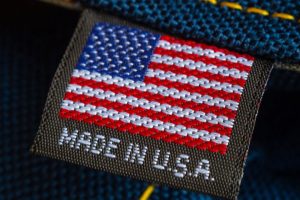 This is a Falcon Super-Action Candid, a solid bodied premium 127 format camera made by the Utility Mfg. Company of New York City starting in 1938. There were a few different variants of the Super-Action Candid, this being the model FE which indicates it has the slower Wollensak f/4.5 lens and an extinction meter. The Super-Action Candid was a significant upgrade to the company’s entry level Falcon Miniature camera, adding better lens and shutter combinations, a focusing helix, and in some cases, an uncoupled extinction meter for assistance with exposure. The Falcon Super-Action Candid was a well built alternative to other American made models like the Detrola and Argus A-series, with a body made of an early plastic called Neilite which is said to be more resistant to cracks and chips than Bakelite.
This is a Falcon Super-Action Candid, a solid bodied premium 127 format camera made by the Utility Mfg. Company of New York City starting in 1938. There were a few different variants of the Super-Action Candid, this being the model FE which indicates it has the slower Wollensak f/4.5 lens and an extinction meter. The Super-Action Candid was a significant upgrade to the company’s entry level Falcon Miniature camera, adding better lens and shutter combinations, a focusing helix, and in some cases, an uncoupled extinction meter for assistance with exposure. The Falcon Super-Action Candid was a well built alternative to other American made models like the Detrola and Argus A-series, with a body made of an early plastic called Neilite which is said to be more resistant to cracks and chips than Bakelite.
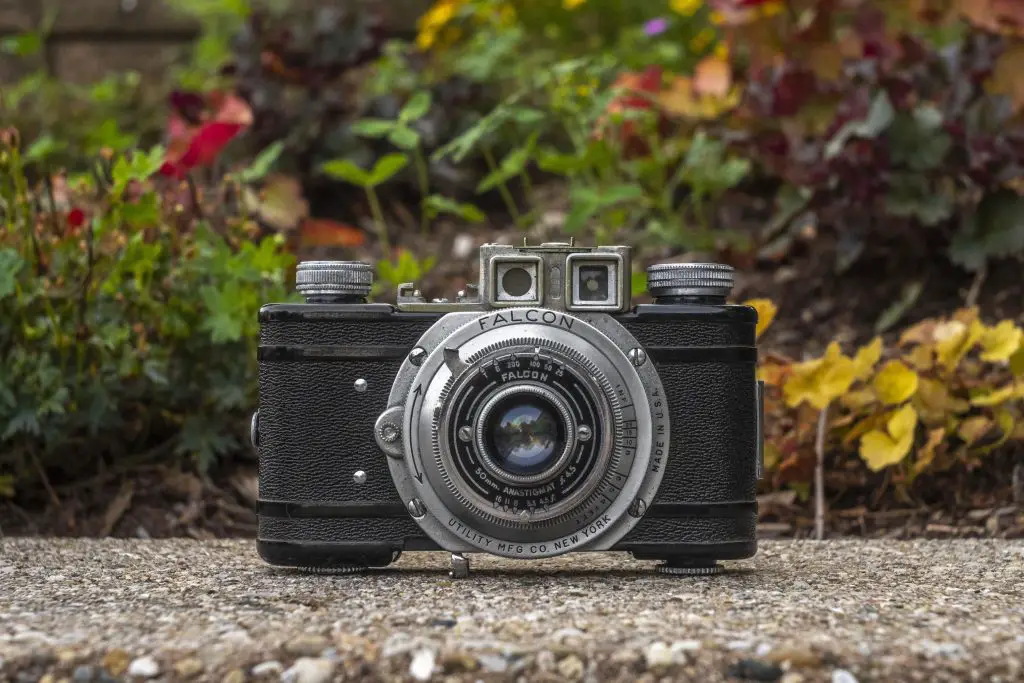 Film Type: 127 Roll Film (sixteen 3cm x 4cm exposures per roll)
Film Type: 127 Roll Film (sixteen 3cm x 4cm exposures per roll)
Lens: 50mm f/4.5 Wollensak Anastigmat uncoated 3-elements
Focus: 4 feet to Infinity
Viewfinder: Scale Focus
Shutter: Wollensak Alphax Jr Leaf
Speeds: T, B, 1/25 – 1/200 seconds
Exposure Meter: Uncoupled Extinction Meter
Battery: None
Flash Mount: None
Weight: 603 grams
Manual: http://www.cameramanuals.org/pdf_files/falcon_candid_camera.pdf
How these ratings work |
The Falcon Super-Action Candid was a medium quality camera produced by a company more commonly known for cheap basic point and shoot cameras in the 1930s. It has a capable shutter and lens and with a focusing helix, it is easy to narrow down sharp images. This camera has a distinct look and in working condition would have been capable of some really nice shots on 127 format film. It’s not exactly desirable, but for a very brief point in time would have been consider a viable option for someone looking for a capable and portable medium format roll film camera. | ||||||
| Images | Handling | Features | Viewfinder | Feel & Beauty | History | Age | |
| 1 | 1 | 1 | 0 | 1 | 1 | 40% | |
| Bonus | none | ||||||
| Final Score | 7.0 | ||||||
History

The Falcon Super-Action Candid was a premium model in a series of Falcon Miniature cameras produced in the late 1930s by the Utility Mfg Co of New York. Entry level Falcon cameras started at $2.49 and were made entirely of cheap plastic and had simple lenses and single speed shutters. Most were designed for 127 format roll film, but some supported larger 120 roll film. There were solid bodied cameras with collapsible lenses, folding cameras, box cameras, and pseudo-TLRs that all appeared with the Falcon name.
Advertisements for the Utility Manufacturing Company listed it’s address as 40 W. 25th St, New York City….aaaaannnnddd that’s pretty much all we know for sure.
There are bits and pieces of information out there such as in McKeown’s 2005-2006 Guide that suggests that Utility was founded in 1934, or this page that suggests the company was founded by a man named Charles Fischburg, or this page that suggests that at one time, Utility was the fourth largest camera maker in the United States.
I have no reason to doubt any of these claims, but each of them stand on their own as small little glimpses into a company that we know so little about. Making matters more complicated is that the name “Utility Manufacturing Corp” was so generic that it was used by a variety of other companies in various industries, from all over the US. I found evidence of companies with the same name in Baltimore, MD, Cudahy, WI, and Chicago IL.
Perhaps the most interesting, and also very confusing, aspect to the Falcon story is what happened around 1940 when the entire lineup, and perhaps Utility Mfg Co themselves, became subsidiaries of Spartus Corp. of Chicago. Initially, cameras bearing the Falcon name continued to be sold under the Utility Mfg Co name, but with a Chicago address, but eventually becoming part of the larger Spartus corporation.
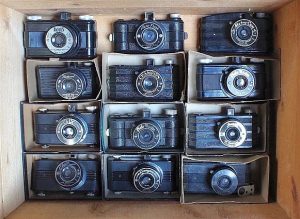
Spartus was the most common brand in the so called “Chicago Cluster” which was a huge number of what appeared to be separate companies operating under a variety of names like Herold, Acro, Carlton, Elgin, Clix, Churchill, Champion, Fleetwood, and many others.
This “cluster” of names was the doing of a Chicago businessman named Jack Galter. Galter was a Russian Jew whose family relocated to America in the early 20th century and by the 1920s became a locally famous jazz drummer who toured local clubs and socialized with notorious criminals like Al Capone and other gangsters.
It was perhaps this influence that taught Galter some of the less “ethical” business practices that he would later employ. When the depression of the 1930s hit, Galter’s career as a musician no longer paid the bills, so he worked for his father-in-law, Henry T. Schiff as an apprentice at his company Electric Clock Corporation of America.
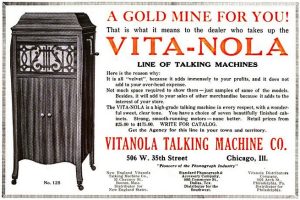
Like Galter, Schiff was a Jewish immigrant whose family emigrated to the United States, and around the turn of the century founded his own Chicago based phonograph company called the Vita-Nola Talking Machine Company. This name was intentionally similar to the much more well known Victrola phonograph built by the Victor Talking Machine Company.
Although this got him into some legal trouble, it was not enough to stop him, and this helped Schiff learn that he could come very close to copying an existing name, without actually violating any copyrights, and get away with it while building sales through brand recognition. This was a lesson that he would imprint upon young Galter.
By the early 1930s, Schiff stopped making phonographs and invested into a large number of smaller and more profitable industries, making clocks, razors, and whatever else he thought he could make a buck from. Schiff’s products were sold by similar sounding names such as Luckey Strike Mfg. Co., Motor Engineering Company, Match King Inc., and Elgin Laboratories. He was often sued by the companies whose names he was mimicking, but always found a way out of major penalties and with each company that was shut down, he had another ready to go.
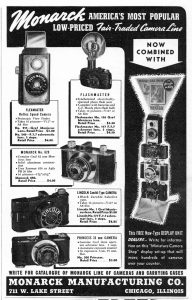
While working for Schiff, Galter adhered to the same sleazy principles, first making cheap electric clocks and razors under his own similar sounding names. One of Galter’s earliest brands was Monarch Manufacturing Co. (sometimes spelled Monarck) who produced small trinkets like key holders, cigarette lighters, and other low-cost household products. With each new product came a new name, one of which was Spartus.
In 1938 as the American camera industry was taking off with new models from Argus, Universal, and a few others, Galter decided to take his brand strategy to the photographic industry and release his own line of cheap knock-off cameras. Galter had no interest in competing with the likes of Kodak or other makers of high quality cameras, he wanted cheap models that could be sold quickly and produced cheaply.
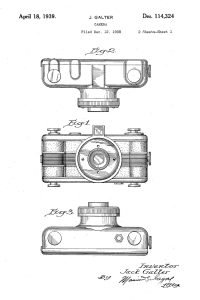
On December 12, 1938, Jack Galter filed a design patent for his own camera that would be the foundation of his own line of cheap Bakelite cameras, some even using the Falcon name.
Using his own designs, Galter began to corner the ultra-low end of the camera market, and by 1940 or possibly 1941, had acquired the Utility Mfg. Co. as yet another name in his large collection of brands. Whether Galter acquired Utility through some type of legal action or simply by buying them out is unknown, but knowing Galter wasn’t afraid to exercise questionable business practices, there’s a good chance it was messy.
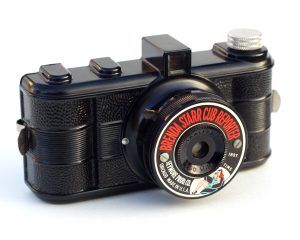
Throughout the rest of the 1940s, Jack Galter and his various names continued to be successful despite numerous lawsuits and legal actions taken by the Federal Trade Commission. His practice of ever changing names allowed him to be elusive and continue his operations each time one of his companies was shut down. He never invested enough into any one of his ventures to allow it to hurt him if something happened. This also proved to be beneficial in the marketplace as many of his products were never around long enough to develop a poor reputation.
Galter became a master of manipulating the trademark system, often capitalizing on vague trademarks such as “zipper”, finding loopholes and other methods for escaping any sort of true punishment.
Galter and his companies stayed in the photographic market until at least until the late 1950s, continuing to produce cheap cameras, many under the Spartus name. By this time, he and his wife Dollie began investing money into real estate where they made an even bigger fortune.


Thus far in this article, I’ve painted Jack Galter to be a sleazy unscrupulous cheat, who likely had low morals, and while many of the things he did helped support those descriptions, in reality Jack and Dollie Galter were very generous in their community, donating millions of dollars to local charities and hospitals such as Chicago’s Northwestern Memorial Hospital and the Swedish Covenant Hospital. To honor their generosity, in 1997, Northwest Memorial Hospital opened the Galter Pavilion, a 22 floor building as the centerpiece of their Chicago campus. The Galter LifeCenter, which is part of the Swedish Covenant Hospital in Chicago is also named in their honor.

Although not technically part of the Chicago Cluster, the Falcon Super-Action Candid’s DNA lived on in the companies future products and as such is often considered closely related. The Super-Action Candid was quite a bit more advanced than later Falcon cameras, but remains a curious relic in the collector’s world.
Originally selling in four different varieties with prices ranging from $17.50 to $23.50, the camera was a step up from entry level Falcons and other Spartus cameras, but was still affordable by the average working family man.
Since it so closely resembles so many other cameras produced during the late 1930s, I doubt many people specifically seek these models out, which is a shame because they are quite nice little shooters. Combined with decent Wollensak lenses the 3cm x 4cm images they make on 127 roll film can be quite nice.
Today, the Falcon Super-Action Candid is but a curiosity that is likely glazed over by most collectors. Unless you have a specific fondness for 127 roll film American cameras, this isn’t likely one to attract much attention, which is a shame because this is a neat camera. It’s a premium Bakelite camera with a focusing helix, extinction meter, and a capable lens/shutter combination. The entry level Falcon cameras might not be all that exciting, but if this Falcon ever crossed your path, you may want to reconsider.
Repairs

I picked up this camera in a lot of old cameras that I found in the basement of Central Camera in downtown Chicago. Everything in the box was sold as broken or for parts and had been down there for an unknown number of decades. When I first saw the Falcon, I was excited as I was on a 127 kick, but as was the case with everything else in that box, was in a state of disrepair.
After a gentle wipe down and exercising of the shutter, I could see the camera was in mostly functional condition except that the focus ring was stuck. This camera has a design similar to another 127 camera of the day, the Acro Model R by Scientific Products Company in which the focus helix is made of a low grade metal that oxidizes and completely seizes up over the years. I have one of these Acro cameras and I’ve tried every trick in the book to move the focus ring to no avail.
I assumed the Falcon had the same problem, and I was ready to move it to shelf duty until I remembered this “one simple trick”. RTFM.
Yep, I read the manual and saw that this Falcon Super-Action Candid has a focus lock that must be pressed in while rotating the focus ring. I did that and to my surprise, it worked! It was stiff, but I was able to move it from minimum focus to infinity and back, several times! Confident with my “repair”, I moved the camera to the active queue for it’s first roll of film!
My Thoughts
In some ways, the Falcon Super Action Candid is much like any other half frame 127 camera of the day. It’s got a black plastic body that’s curved on the front edges and angled in the back and strongly resembles the Argus A-series. It has some variation of a collapsible Wollensak shutter and lens, and it was cheaply made. The entire lineup of 127 cameras by Detrola pretty much followed the exact same formula.

In fact, if you’ve ever used a Detrola or an Argus A-series before, then you have a pretty good idea of what using this camera is like, the only difference is that everything on the Falcon is just a little bit heavier, a little more stout, and there’s that focus lock. A focus lock you say? Yeah, there’s a button at the 9 o’clock position around the shutter that must be pressed and held in any time you rotate the focus ring. Each time you release this button, some internal component engages and prevents any movement of the helix. It’s this lock that cause most people (myself included) to think the Falcon is seized, when it isn’t.

The top of the camera is dominated by the extinction meter, which I’ll get to in a moment. On the left is a large film advance knob with an arrow indicating which direction it turns. As the knob turns, there are audible clicks that suggest some type of ratcheting system to ensure the film can never be wound in the incorrect direction. On the opposite side is another knob, but it doesn’t actually do anything other than function as a spool release that you pull up on while loading film into the film compartment. I appreciate symmetry with the knobs, even if the second one doesn’t do much.

Extinction meters were common on inexpensive cameras from the 1930s as an early form of exposure metering. How it works is that there is an opening somewhere on the camera that has an opaque film on it with a series of semi transparent numbers or letters that start off very dark and get progressively lighter and lighter.
The photographer would look through the extinction meter and starting with the lightest letter, move to the next darkest letter until he or she cannot read the letters anymore. The last letter he could see, would be the metered letter, which he would then transfer to a dial somewhere else on the camera to get a shutter and f/stop reading.
I’ve shown images of what extinction meters look like before in my reviews for Perfex Speed Candid and Perfex Forty-Four, but strangely, the one on this Falcon has disintegrated into a brownish circle. I can’t honestly understand how it worked in the first place, but based on the large numbers 1-8 on the extinction meter dial, I assume that those numbers would have shown up somewhere in that circle. If anyone has a Falcon Super-Action Candid with a good extinction meter and can take a picture of it and send it to me, that would be awesome. That said, even if the meter was functional, I likely wouldn’t have ever used it, as calculating outdoor exposures through Sunny 16 is far simpler in my opinion.

The back of the camera is a solid piece of die cast metal that weighs 172 grams, which considering the whole camera weighs only 603 grams, that means the back accounts for nearly 29% of the whole camera’s weight!
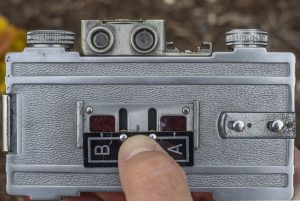
This being a 3×4 camera, there are two red windows with a sliding door for keeping track of the exposure numbers on the film’s backing paper. Normal 127 film never had exposure numbers for 3×4, so you have to use the numbers for 6×4.5 exposures. How it’s done is that when advancing the film, the first frame is shot with the number 1 in the red window on the right. For the second frame, advance the film until the number 1 is in the red window on the left. For the third frame, the number 2 must be in the window to the right, and so on. You have to remember to use every frame number twice. The 16th and final image is shot with the number 8 in the left red window.
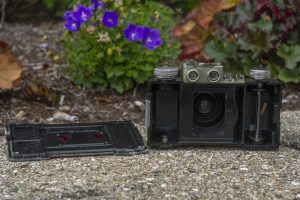
For loading film, you must remove the back by pushing on a spring loaded clip on the right and unhook it from a metal latch on the left and lifting the door off. Film travels from right to left onto standard 127 spools. If you buy a camera like this, you’ll want to make sure there’s at least one empty spool in the camera, otherwise you’ll need to locate one before you can shoot it.
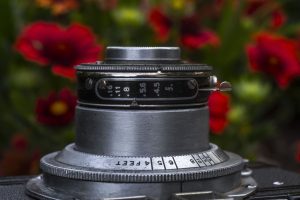
The Falcon Super-Action Candid has a collapsible shutter which requires you to extend it before shooting. On some camera, collapsible shutters can be problematic as you need to remember to extend them before exposing an image. Failing to do so results in wildly out of focus shots. The design of the Falcon makes this incredibly unlikely to happen as the shutter is extended via the focusing helical. You cannot focus the camera without first extending the shutter which all but eliminates the chances of someone forgetting to do it. And don’t forget that focus lock button on the side that I previously mentioned, you cannot rotate the focus wheel at all, not even to extend the shutter without first pressing it!
An aperture scale with a metal pointer can be easily seen from the top of the shutter, with the shutter release lever on the right. When holding the camera, the position of the shutter release naturally falls where your right index finger wants to go.
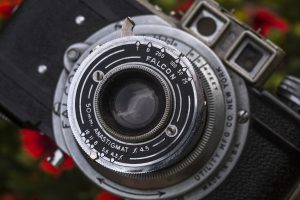
Changing the aperture is done by moving a metal lever at the base of the front of the shutter. The Model FE being reviewed here has an f/4.5 lens, but an f/3.5 lens was also available in the Model GE. At the top of the front of the shutter is the shutter speed selector, showing four speeds from 25 to 200, plus T and B. Also visible in this picture is a tiny fold down kickstand on the base of the camera that helps support the lens while it’s extended and the camera is placed on a flat surface.
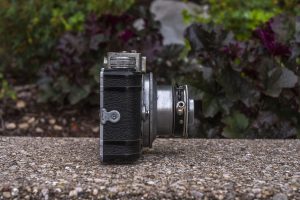
The sides of the camera don’t have much to show. In the image to the left, you can see the latch that holds the back of the camera on and the shutter release latch and threaded socket for a shutter release cable.
I don’t have any images of the viewfinder, as it’s just a straight through view approximating the 3cm x 4cm images that the Falcon Super-Action Candid makes.
The Falcon Super-Action Candid is a predictably easy to use camera with a feature set above that of a huge number of entry level cheap plastic cameras of the day. Does it’s enhanced feature set result in enhanced quality images?
My Results
For the first roll through the Falcon Super-Action Candid, I chose a roll of black and white Supretone film that expired some time in the 1960s. Although half a century old, I’ve shot this film in various other cameras like the Yashica 44 to great success. Somehow, this film has stood up to the rigors of time and is capable of sharp and contrasty film with low grain and no age related anomalies. It rates at an approximate ASA 25 speed film, which is perfect for the relatively slow shutter of the Falcon.
I have experience with Supretone film and Wollensak lenses. I was pretty optimistic about the images that I would get from the Falcon and after seeing my results, I was mostly happy.
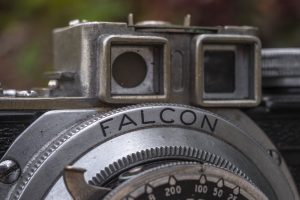
There are a couple of light leaks which I wasn’t surprised to see since the rear door has nothing resembling any type of light sealing material, but I also had to wonder how often light leaks would have been common back when this camera was new. There’s nothing different about how I would have used it today compared to 70 years ago when it was new. Although many films available today are significantly faster, and more prone to light leaks than film from back then, but I was using 50 year old ASA 50 speed film, so I wasn’t that far off from the sensitivity of film from back then.
There is some evidence of haze in the lens which also wasn’t a surprise, especially considering this camera likely spent decades in a cool damp basement in the Chicago Loop.
Overall, I was pleased with the images though. These are bona fide vintage-y looking images, no Instagram filters required. Using the camera was mostly a painless process. I found that by leaving the camera in it’s leather case, that the little door that covers the two red windows on the back of the camera would keep hitting the leather as I tried to see the exposure numbers after each number.
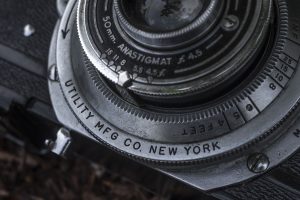
The Falcon Super-Action Candid was a pretty well featured camera compared to the rest of the Falcon/Spartus lineup, but I’m not convinced the images I got from it were any better than I might have gotten with a lesser camera. It’s important to remember that these were cheap cameras that were not built to the highest tolerances.
I enjoyed my experience with the Falcon. The images had a distinct look, there were light leaks, I didn’t nail focus 100% of the time, and with the larger size of 127 film compared to other 35mm cameras, there’s a decent amount of sharpness.
That said, am I likely ever to shoot this camera again? Probably not. Although I currently have a small supply of 127 film, its still precious enough that I’ll likely save it for more interesting cameras.
Related Posts You Might Enjoy
External Links

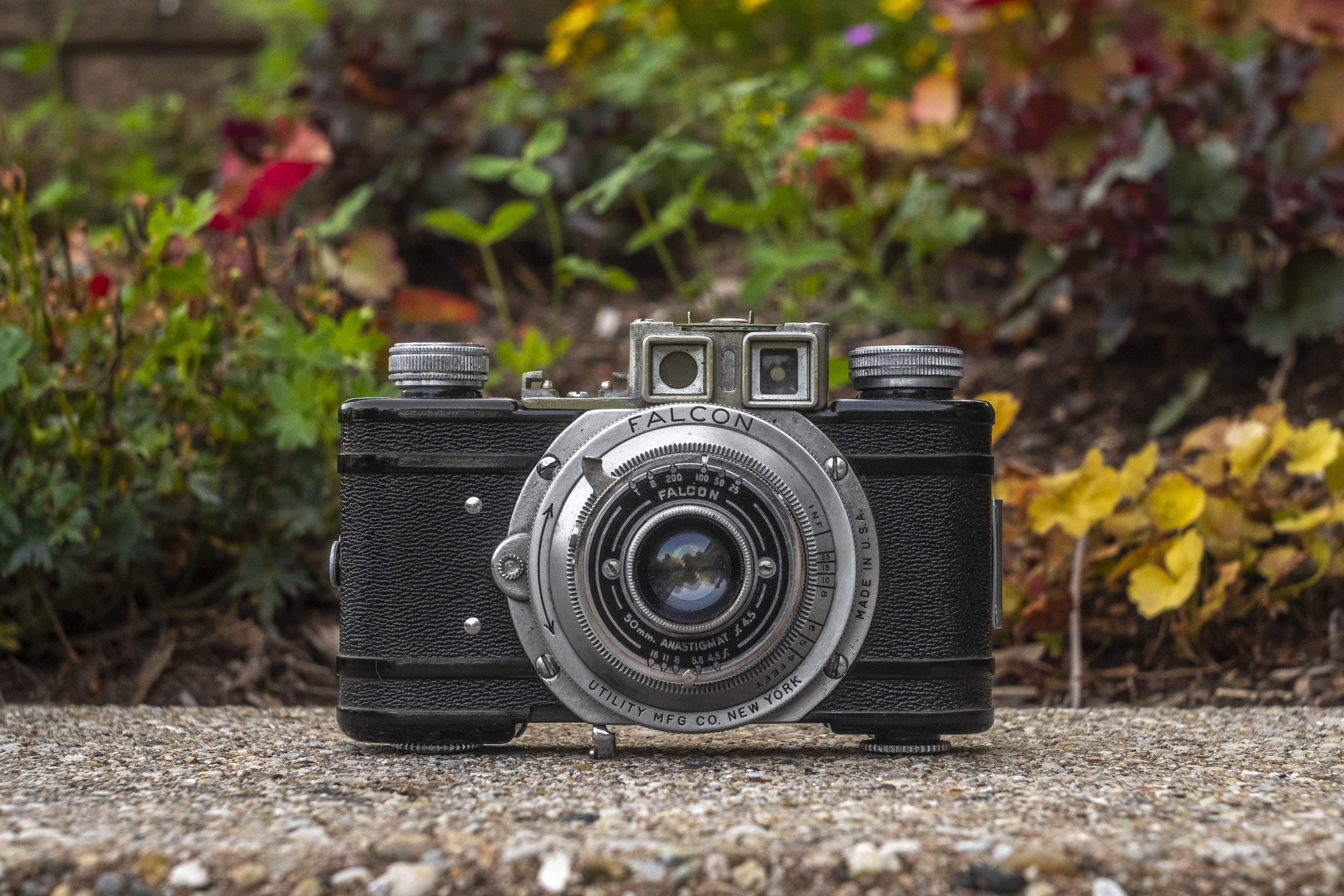













Thanks for the very detailed info you dug up on Jack Galter and Henry Schiff. IMHO the classic history of American miniature cameras is “Glass Brass & Chrome” by Lahue and Bailey. However, they concentrate on 35mm and 00 film cameras to the exclusion of models that shot 127. The images you shared from your Falcon look very 1930s style, and you got those results without resorting to PhotoShop. Cool!
I actually asked Rick Oleson to look through his copy of “Glass, Brass, and Chrome” to see if there was any more information about Utility Mfg Co in there, and other than the same info commonly shared online, even those guys didn’t have much to say. That company truly is an enigma.